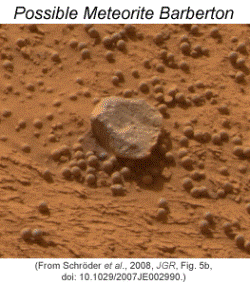
Possible relation to Victoria Crater?
Santa Catarina and a large accumulation of similar ‘cobbles’ (not studied or analysed, of unknown composition) were found on the rim of Victoria Crater (Figure 4), and this impact may have formed the crater, but the association may be coincidental, particularly as they are only on one side of the crater.
Figure 4. Barberton. This again is finely even textured and does not resemble a mesosiderite.
Relation to the six irons found by Opportunity?
A genetic link between these stony irons and the six irons found by Opportunity
1 is unlikely, and the weathering states suggest that these may be from a later fall.
Possibility of long term survival of meteorites on Mars’s surface, from a time of a denser atmosphere, or more recent descent through the current thin atmosphere
The possibility has been suggested that these meteorites arrived long ago, at a time when the Mars atmosphere was denser and more resistant to incoming objects, but the accepted thinking is surely that this was millions of years ago, and descent through the present thin atmosphere is also possible? Bland and Smith
5 suggested that masses of up to 0.1kg could come through the current Mars atmosphere and survive. The masses are estimated as Barberton, 20-25g; Santa Caterina, 2.5- 3.1kg; Santorini, 427-528g; Kasos, 373-463g.
Tests on meteoroids up to 10kg have been inconclusive whether such bodies could fragment and disperse through atmospheric drag, coming down through the current thin Mars atmosphere. Rare incidence at very shallow angles cannot be ruled out? Yet with very slow weathering processes at the surface and beneath it, and possible burial and exposure at the surface by deflation of cover, even more than once, it seems just credible that iron and stony iron/stony meteorites such as are described here could have fallen to the surface even millions or billions of years ago and still be preserved on the surface?